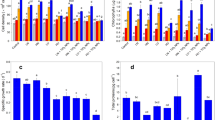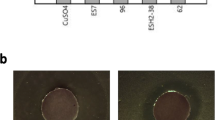Abstract
The widespread occurrence of cyanobacteria blooms damages the water ecosystem and threatens the safety of potable water and human health. Exogenous L-lysine significantly inhibits the growth of a dominant cyanobacteria Microcystis aeruginosa in freshwater. However, the molecular mechanism of how lysine inhibits the growth of M. aeruginosa is unclear. In this study, both non-target and target metabolomic analysis were performed to investigate the effects of algicide L-lysine. The results showed that 8 mg L− 1 lysine most likely disrupts the metabolism of amino acids, especially the arginine and proline metabolism. According to targeted amino acid metabolomics analysis, only 3 amino acids (L-arginine, ornithine, and citrulline), which belong to the ornithine-ammonia cycle (OAC) in arginine metabolic pathway, showed elevated levels. The intracellular concentrations of ornithine, citrulline, and arginine increased by 115%, 124%, and 19.4%, respectively. These results indicate that L-lysine may affect arginine metabolism and OAC to inhibit the growth of M. aeruginosa.
Similar content being viewed by others
References
Cai YP, Weng K, Guo Y, Peng J, Zhu ZJ (2015) An integrated targeted metabolomic platform for high-throughput metabolite profiling and automated data processing. Metabolomics 11:1575–1586
Dai R, Liu H, Qu J, Zhao X, Hou Y (2009) Effects of amino acids on microcystin production of the Microcystis aeruginosa. J Hazard Mater 161:730–736
de Figueiredo DR, Azeiteiro UM, Esteves SM, Goncalves FJ, Pereira MJ (2004) Microcystin-producing blooms-a serious global public health issue. Ecotoxicol Environ Saf 59:151–163
Huisman J, Codd GA, Paerl HW, Ibelings BW, Verspagen JMH, Visser PM (2018) Cyanobacterial blooms. Nat Rev Microbiol 16:471–483
Kaya K, Sano T (1996) Algicidal compounds in yeast extract as a component of microbial culture media. Phycologia 35:117–119
Khangulov SV, Sossong TM Jr, Ash DE, Dismukes GC (1998) L-arginine binding to liver arginase requires proton transfer to gateway residue His141 and coordination of the guanidinium group to the dimanganese(II,II) center. Biochemistry 37:8539–8550
Kroeckel S, Dietz C, Schulz C, Susenbeth A (2015) Bioavailability of free lysine and protein-bound lysine from casein and fishmeal in juvenile turbot (Psetta maxima). Br J Nutr 113:718–727
Landsberg JH (2010) The Effects of harmful algal blooms on aquatic organisms. Rev Fish Sci 10:113–390
Li D, Wu N, Tang S, Su G, Li X, Zhang Y, Wang G, Zhang J, Liu H, Hecker M, Giesy JP, Yu H (2018) Factors associated with blooms of cyanobacteria in a large shallow lake, China. Environ Sci Eur 30:27
Lurling M, van Oosterhout F (2014) Effect of selected plant extracts and D- and L-lysine on the cyanobacterium Microcystis aeruginosa. Water 6:1807–1825
Paerl HW, Huisman J (2008) Climate. Blooms like it hot. Science 320:57–58
Paerl HW, Otten TG (2013) Harmful cyanobacterial blooms: causes, consequences, and controls. Microb Ecol 65:995–1010
Paerl HW, Otten TG, Joyner AR (2016) Moving towards adaptive management of cyanotoxin-impaired water bodies. Microb Biotechnol 9:641–651
Sanchez-Baracaldo P, Cardona T (2020) On the origin of oxygenic photosynthesis and Cyanobacteria. New Phytol 225:1440–1446
Takamura Y, Yamada T, Kimoto A, Kanehama N, Tanaka T, Nakadaira S, Yagi O (2004) Growth inhibition of Microcystis Cyanobacteria by L-lysine and disappearance of natural Microcystis blooms with spraying. Microbes Environ 19:31–39
Tian L, Chen M, Ren C, Wang Y, Li L (2018) Anticyanobacterial effect of L-lysine on Microcystis aeruginosa. RSC Adv 8:21606–21612
Wilson AE, Sarnelle O, Neilan BA, Salmon TP, Gehringer MM, Hay ME (2005) Genetic variation of the bloom-forming Cyanobacterium Microcystis aeruginosa within and among lakes: implications for harmful algal blooms. Appl Environ Microbiol 71:6126–6133
Yamamoto Y, Kouchiwa T, Hodoki Y, Hotta K, Uchida H, Harada KI (1998) Distribution and identification of actinomycetes lysing cyanobacteria in a eutrophic lake. J Appl Phycol 10:391–397
Yan XC, Xu XG, Wang MY, Wang GX, Wu SJ, Li ZC, Sun H, Shi A, Yang YH (2017) Climate warming and cyanobacteria blooms: looks at their relationships from a new perspective. Water Res 125:449–457
Zhang BH, Chen W, Li HQ, Yang JY, Zha DM, Duan YQ, Hozzein WN, Xiao M, Gao R, Li WJ (2016) L-valine, an antialgal amino acid from Streptomyces jiujiangensis JXJ 0074(T). Appl Microbiol Biotechnol 100:4627–4636
Zhang H, Liu Y, Nie X, Liu L, Hua Q, Zhao GP, Yang C (2018) The cyanobacterial ornithine-ammonia cycle involves an arginine dihydrolase. Nat Chem Biol 14:575–581
Acknowledgements
This work was supported by the National Natural Science Foundation of China (Grant Nos. 41877336, 41971043, and 42077122) and Jiangsu Provincial Natural Science Foundation of China (Grant No. BK20200093). We thank LetPub (www.letpub.com) for its linguistic assistance during the preparation of this manuscript.
Author information
Authors and Affiliations
Corresponding author
Additional information
Publisher’s Note
Springer Nature remains neutral with regard to jurisdictional claims in published maps and institutional affiliations.
Rights and permissions
Springer Nature or its licensor (e.g. a society or other partner) holds exclusive rights to this article under a publishing agreement with the author(s) or other rightsholder(s); author self-archiving of the accepted manuscript version of this article is solely governed by the terms of such publishing agreement and applicable law.
About this article
Cite this article
Yan, X., Zhao, F., Wang, G. et al. Metabolomic Analysis of Microcystis aeruginosa After Exposure to the Algicide L-Lysine. Bull Environ Contam Toxicol 110, 12 (2023). https://doi.org/10.1007/s00128-022-03658-5
Received:
Accepted:
Published:
DOI: https://doi.org/10.1007/s00128-022-03658-5









